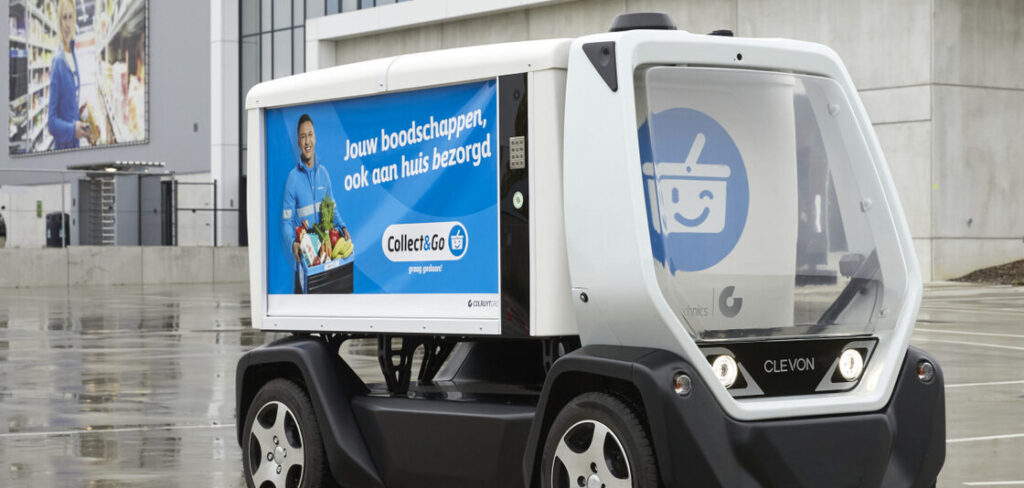Colruyt Group’s online shopping service Collect&Go has begun testing a vehicle provided by technology company Clevon that combines remote teleoperation with autopilot functionality. The group aims to capitalize on the trend of e-commerce and ecological electric transportation in densely populated areas
The Clevon 1 is a compact, all-electric vehicle that has sufficient storage space and can be closed with a numerical or QR code. Remotely controlled, the self-driving vehicle will cover a 4km route on public roads from the distribution center to Collect&Go’s pick-up point in Londerzeel, Belgium. The first test runs of the Clevon 1 took place in the parking lot of the distribution center in Londerzeel.
The Clevon 1 operates using vision technology, machine learning and sensors and can travel at around 50km/h (but is staying under 25km/h in the initial test phase). In a controlled environment, it can be operated in autopilot mode. In this road test, the vehicle will undertake several general driving tasks autonomously with a teleoperator supervising at all times. The teleoperator can also take control of the vehicle at any time for safety reasons.
To observe its surroundings, Clevon 1 uses three front cameras, two side cameras and one rear camera. It is also equipped with short- and long-range radars, which can measure distances and detect and identify obstacles such as cars, cyclists and pedestrians. In this way, it has a clear field-of-view of its surroundings and can predict and thus avoid possible collisions in traffic. Clevon uses multiple deep neural networks, fusing camera and radar information to enable the vehicle to detect and identify the dynamic environment. The technical team at Clevon expects that in the future, one teleoperator will be able to manage five to 10 vehicles simultaneously.
The mayor of Londerzeel and local police forces are also closely involved in this pilot project and are responsible for safety and guidance along the route. A license from the Federal Government Department of Mobility was required to run a remote-controlled car on public roads, even in a well-supervised test. The Belgian road safety institute Vias mapped all possible risks.
The Clevon 1 communicates with the operator in the control room via 4G. Kim Vancauwenberghe, managing director of Colruyt Group Smart Technics, commented, “Reliable data connectivity is crucial for this technology. To be sure, the vehicle has two SIM cards from two different providers, so there is always a network available. In the unlikely event that both networks fail, the unmanned vehicle comes to a safe stop. In this first phase, we mainly want to test the technology, study what the vehicle is already capable of and see how, together with the local and federal government, we can provide not only safe but also ecological transport on public roads in an urban environment. The tests not only provide useful insights for the online shopping service Collect&Go – other formulas in our group are also following the study with great interest.”
Tom De Prater, business unit manager for Collect&Go, said, “Online grocery shopping is an important pillar for Colruyt Group and it is our ambition to be and remain best of class in this. In a rapidly changing e-commerce context, we are therefore constantly looking for ways to organize the last mile as efficiently and sustainably as possible. There is already a worldwide shortage of drivers, the cost of those last kilometers is sky high and mobility in cities is a real challenge. Investing in innovation, new solutions and state-of-the-art technologies is therefore crucial. This pilot project obviously fits in with that. We are enthusiastic about the potential; at the same time, we are very realistic and will proceed step by step.”
Sander Sebastian Agur, CEO of Clevon, stated, “Our third-generation autonomous driving vehicle Clevon 1 has the necessary permits to drive on public roads in Estonia and Lithuania. License applications are pending in the United States and many other European countries. Our driverless, all-electric vehicles have already been in city traffic for two and a half years with an impeccable safety record, proving that the technology is functional and safe for everyone around.”
Georges Gilkinet, Belgium’s Federal Minister for Mobility, added, “Self-driving cars are an additional mobility choice that can usefully complement existing public transport. Together with the regions and the sector, I want to establish a regulatory framework for the development of self-driving cars. That is why we support these tests. For the logistics sector, the self-driving car has interesting potential, but it is not the only option to be further developed for the future. Cargo bikes for the last mile or rail for long distances also still have a lot of potential as competitive transport solutions. After all, a self-driving car stands still in traffic jams just as well as a classic car.”


